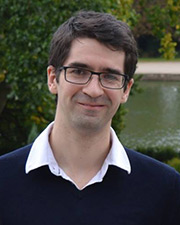
Oscar Woolnough, PhD
- Assistant Professor
- Human Cognitive Neuroscience
Contact
Biography
Dr. Oscar Woolnough received his Ph.D. in Neuroscience at the University of Nottingham in the United Kingdom. His academic training and research experience combine human cognitive neuroscience with engineering and mathematical analysis.
He joined the laboratory of Dr. Nitin Tandon at UTHealth Houston for his postdoctoral training on using intracranial recordings to study human language. He conducts studies of visual word reading, speech production, and memory recall using intracranial recordings and direct cortical stimulation in large populations of epilepsy patients. This research combines basic science investigations of literacy with the translation of these findings into neurosurgical practice, developing methods to pre-surgically and intraoperatively map eloquent brain function. Dr. Woolnough was promoted as an Assistant Professor in 2024.
Dr. Woolnough has published 16 research articles in scientific and clinical journals including Nature Human Behaviour, Proceedings of the National Academy of Sciences (PNAS), Brain, and The Journal of Neuroscience.
Education
- Doctorate, Neuroscience
- University of Nottingham, United Kingdom
- Postdoctoral Training
- Department of Neurosurgery, UTHealth Houston
Areas of Interest
Research Interests
Dr. Woolnough’s research utilizes human intracranial recordings to investigate the neural representations that underpin our ability to read. The high spatiotemporal resolution of intracranial recordings allows the tracking of the dynamic spread of information across the brain’s surface, the interactions between multiple functional neural hubs, and the representation of the statistical properties of language that govern our reading speed. By using direct cortical stimulation through the same electrodes, transient disruptions of function can be produced, allowing a causal link to behavior.
To recognize a word, we must convert from a combination of visual lines on the retina into an invariant representation of letters, and then link this to a word in our internal dictionary. This process is highly sensitive to the statistics of natural language, allowing easy access to high frequency words, and involves dynamic, recurrent feed-forward and feedback interactions within the visual stream. How do we determine whether a string of letters on a page relates to a word we know? How is information about commonly occurring words encoded into the word recognition process? How does the visual stream interact with the broader reading network to access the correct meaning and pronunciation and allow us to read aloud?
Publications
Representative Publications
O Woolnough, C Donos, PS Rollo, KJ Forseth, Y Lakretz, NE Crone, S Fischer-Baum, S Dehaene, N Tandon (2021) Spatiotemporal dynamics of orthographic and lexical processing in the ventral visual pathway. Nature Human Behaviour
O Woolnough, N Tandon (2024) Dissociation of reading and naming in ventral occipitotemporal cortex. Brain
O Woolnough, C Donos, E Murphy, PS Rollo, ZJ Roccaforte, S Dehaene, N Tandon (2023) Spatiotemporally distributed frontotemporal networks for sentence reading. Proceedings of the National Academy of Sciences
O Woolnough, C Donos, A Curtis, PS Rollo, ZJ Roccaforte, S Dehaene, S Fischer-Baum, N Tandon (2022) A Spatiotemporal Map of Reading Aloud. Journal of Neuroscience
O Woolnough, PS Rollo, KJ Forseth, CM Kadipasaoglu, AD Ekstrom, N Tandon (2020) Category Selectivity for Face and Scene Recognition in Human Medial Parietal Cortex. Current Biology